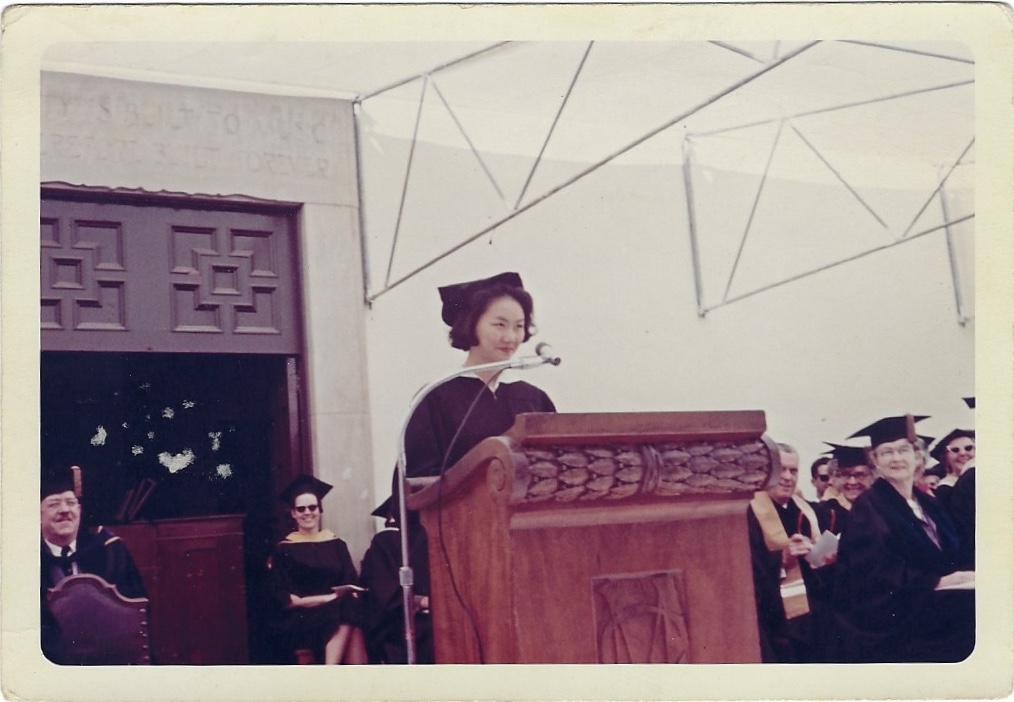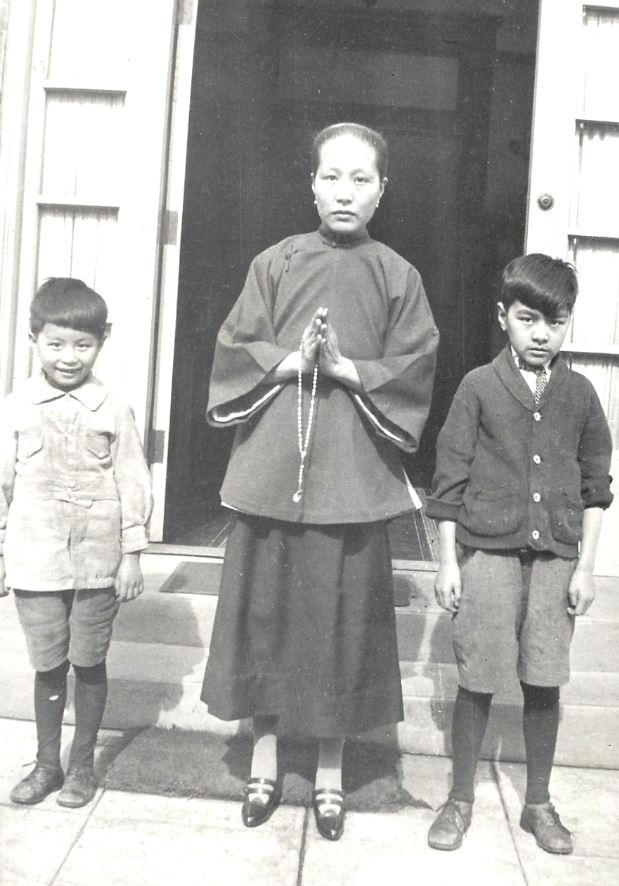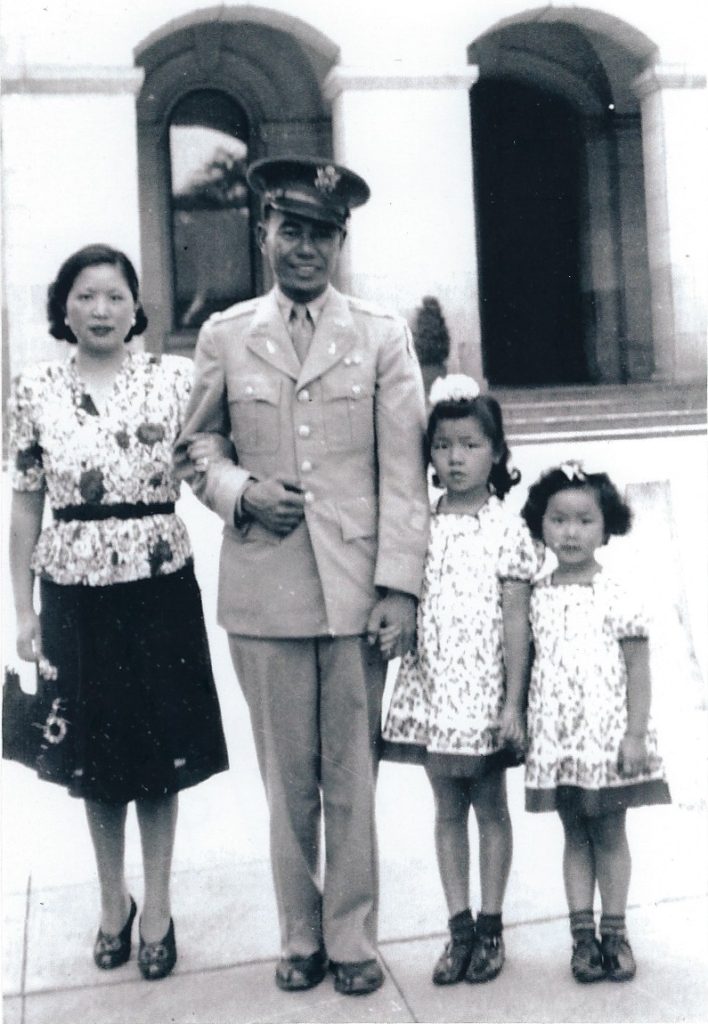By Raymond Douglas Chong (Zhang Weiming)
At the 150th anniversary celebration of the completion of the Transcontinental Railroad at Promontory Summit in Utah , during a chilly and breezy spring dawn, a lone Chinese American woman stood in front between, “Jupiter” and Union Pacific Railroad #119 steam locomotives.
Amid her commencement address, Connie Young Yu, a Chinese railroad worker descendant, poignantly lamented:
My great-grandfather Lee Wong Sang, was one of the thousands of unsung heroes, building the railroad across the Sierra Nevada mountains, laying tracks through to Utah, uniting the country by rail. Many descendants of Chinese railroad workers are here today. This is a far cry from 50 years ago. At the Centennial in Promontory, May 10, 1969, my mother, Mary Lee Young, was the only such descendant present.
Her great grandfather came like thousands of his kinsmen from Sze Yup region of Kwangtung along with his cousins to work on the Iron Road for Central Pacific Railroad. Because of his initiative, he quickly learned English and became a foreman. After a day of the golden spike, when the two Iron Horses met, he was a partner of Quong Shing Lung, an import-export store, at San Francisco Chinatown. Shee Chin, his wife, arrived and gave birth to three sons and one daughter. Wong retired to this village as a respected elder.
Yu’s story was featured in the recently broadcast PBS documentary, Asian Americans.
She grew up in San Francisco with her older sister, Janey Young Cheu, and younger brother, Alfred John Young. Yu graduated from George Washington High School. She studied literature and journalism at Mills College where she was the valedictorian of her 1963 graduating class, with bachelor of arts degree in English. She taught fencing for over 25 years at the Fencing Center of San Jose. She is married to Dr. John Kou Ping Yu, an oncologist.

She actively participated in the preservation of Angel Island Immigration Station in San Francisco Bay. An important part of Asian American history, Angel Island would win designation as a National Historic Landmark in 1997. Connie also spoke on behalf of all the descendants of Chinese Transcontinental Railroad workers when the United States Department of Labor inducted The Chinese Railroad Workers into the Labor Hall of Honor on May 9, 2014, in Washington, D.C.
On May 10, 2019, Connie deeply recalled the precious moments and memories at Promontory Point, Utah, as a Chinese American milestone. She represented the Chinese Historical Society of America. She shared her memories with AsAmNews.
It was a moment 50 years in the making. I was there to finish what was started by Philip Choy, president of the Chinese Historical Society of America who was to present a plaque to Chinese railroad workers at the Centennial (May 10, 1969) and denied the platform at the last minute. I was not alone in this mission, riding to Promontory Summit from Salt Lake City in a car driven by Al Young, my brother, drag racer, and with Dr. John Kou-ping Yu, my husband, who encouraged me all the way.
Upon arrival at the gala 150th anniversary site, filling with thousands and thousands of people, I was nervous, my heart-pounding, and a bit paranoid. I thought of my parents (John Young and May Lee Young) journeying to this very spot, for the 100th anniversary, and how my mother was the only descendant of Chinese Railroad workers present. I was wearing her blue dress and could feel her spirit. And felt I had to succeed, no matter what. Seeing the large, joyful gathering of Asian Americans – many descendants of railroad workers, all looking expectantly at me, I was “on”. I was representing them and our ancestors, the forgotten brave Chinese railroad workers, I felt empowered and strode out confidently on stage. My speech came from the heart and I meant every word I was saying. At the end I could exclaim with total exultation, “Done!”
Yu also contributed to the Connie and Sue Lee edited Voices from the Railroad: Stories by descendants of Chinese railroad workers. This book, published by Chinese Historical Society of America, reveals the stories of Chinese railroad workers and their descendants. Connie wrote the chapter Lee Wong Sang, Laying Tracks to Follow.
“Voices from the Railroad,” is a collection of true stories by nine descendants of Chinese railroad workers. Importantly, it puts the Chinese railroad workers “on the map” of American history, giving humanity to what has been perceived as “nameless thousands of Chinese laborers.” The descendants give evidence of their ancestors’ role on the Central Pacific Railroad, how they survived the hardships and how they and their descendants contributed to America.
For Yu, the awful legacy of the 1882 Chinese Exclusion Act, is not just something she read in the history books. It’s a central part of her family history.
I have always known about the Chinese Exclusion Act from family stories. John Young, my father always told me – how lucky for us that “Gung-Gung (grandfather) came in 1881 at the age of 11, a laborer, one year before the Chinese Exclusion Act (1882). Gung-Gung had re-entry papers to go to China to see his mother and to get married, but could not bring back his wife when he returned to the U.S. He and his wife, my grandmother, were separated for 14 years. Grandpa had to establish himself as a merchant in order to “legally” send for her. There were many more stories of family separations in among my relatives, all sad, and sacrifices were made for the next generation.
I have the “paper trail” of my grandparents, evidence of the trials of the Chinese Exclusion Act. Chinese were denied naturalization to U.S. citizenship and thus, had no rights, and constantly had to prove they had a right to be in this country. I have my grandfather Young’s resident permit, an internal passport for all Chinese required by the Geary Act (1892). For those born in the U.S. during the Exclusion era, proof of citizenship meant life itself, for one’s family as well. My grandfather Yoke Suey Lee, son of the railroad worker, born in San Francisco, rushed back to the store after the Quake and Fire of 1906 to retrieve his birth certificate, and was bayoneted because the soldier thought he was a looter. Luckily, his wound was not deep, and he managed to hobble to safety with his papers stuffed in his heavy jacket. He risked his life to save the proof of American citizenship.

Her grandfather, Yoke, was the first native born American in San Francisco. With his father, Yoke was a merchant of Quong Shing Lung in San Francisco Chinatown. He married Shee Wong and brought her to America. He was an agent in China for American goods for Levi Strauss & Company and Haas Brothers, based in Shanghai, with The Oriental Trading Company. Yoke brought his family to live at Shanghai while children attended Cantonese school. In 1922, aboard a steamer to China, he died of liver cancer.
Shee Wong (Mrs. Yoke Suey Lee) – her grandmother, fought against the 1882 Chinese Exclusion Act and won.

- As a widow of Yoke Suey Lee, with her American born children, she landed to Port of San Francisco, aboard S.S. Cleveland, from Hong Kong, on January 15, 1924. She was detained at Angel Island Immigration Station and was nearly deported. After 16 months, on April 29, 1925, she successfully prevailed in her appeal for immigrant justice and was released from detention.
Angel Island was always in my mother’s view of San Francisco Bay, a reminder of a dreadful ordeal. As a 15-year-old girl, she would take the ferry to visit her mother (Shee Wong) held prisoner at the immigration barracks. Her mother, my grandmother Lee, was detained there for 15 and a half months, January 15, 1924 to April 30, 1925. She was a widow, returning to San Francisco with her U.S. born children, and not allowed to land because she was: #1. A Chinese, an alien ineligible for citizenship by the law of 1924; #2. A widow, therefore, without status; and #3 upon medical examination at Angel Island was found to have liver fluke (filariasis).
About to be deported, she was separated from her children, but the oldest daughter, appealed to a White business associate of her father who hired a lawyer) A first appeal was denied, a second appeal took months. Meanwhile, Grandma was detained, and my mother visited her once or twice a week at the Administration building, only allowed 15 minutes visits. She was like a prisoner. Finally, United States Court of Appeals for the Ninth Circuit ruled that Mrs. Lee be released, on the grounds it was inhumane to separate her from her children, and that it was proven she had a curable ailment. But my mother never forgot the ordeal she and her mother and siblings went through, to be a family separated by a cruel unjust ruling.
In 1974, I went with my mother to Angel Island, for this scene filmed by Freida Lee Mock, for a documentary, Jung Sai, Chinese Americans. My mother had never been to the barracks before, only the administration building (which no longer there) Standing inside the detention barracks, she told me tearfully – “Here is the window where she would wave to me — I could see her hand waving when I was on the walkway going to the ferry” It was an emotional and illuminating experience being with my mother as she recalled her heartbreak. Right at the site of her mother’s detention. Then, my mother saw the poems on the wall, and she read one of them aloud in Cantonese. It was poignant and beautiful. A triumph of sorts. A message from the past – a person imprisoned by the Chinese Exclusion Act, speaking to us.
Mary Lee Young – her mother.
- The only descendant of Chinese railroad worker of the Transcontinental Railroad present at the centennial celebration (May 10, 1969).
Colonel John Young – her father, a Chinese American World War II veteran.

- Born in San Jose, California, John enlisted in the Army ROTC (Reserve Officers’ Training Corps) at Stanford University around 1935. He received his Second Lieutenant commission in 1937 and was a reserve officer until February 1942 when called to active duty. He served in the China Burma India Theater from 1942 until 1945. He left for duty as a Captain and returned stateside as a Major. He consistently served in combat zones along the Burma Road. He served under General Stilwell as an ordnance officer and in airdrop operations. He returned to the U.S. as a Major and separated from active duty in December 1945. Young was recalled to active duty as a Lieutenant Colonel during the Korean War and served from 1951 to 1953. He retired from the U.S. Army Reserve as a Full Colonel in 1972.
As a Chinese and as a woman, Connie shared her experiences of racial and sexist discrimination, in school.
Chinese could not buy homes outside of San Francisco Chinatown in the 1940s and 1950s. We were able to move to the Richmond District, only because my dad, a World War II veteran and officer in the U.S. Army Reserve and had a fellow officer (German- American) buy the house first and sell it to him.
I did not experience overt racism in the public-school classroom, though all of us were taught American history was only about White people, and Western civilization was the only real civilization in the world. Most labor unions still excluded Chinese and Blacks. There was a glass ceiling for Chinese professionals. I attended a great high school – George Washington High School Class of 1959 but the whole society was sexist. Girls were second-class citizens, verbally insulted, whistled at and it was accepted. We did not have any varsity sports, girls were never class or elected student body president, but fine for vice president or secretary. Asian girls stereotyped as exotic, etc.
Things changed in a positive way for me going to Mills College, a liberal arts women’s college, at Oakland, California. Women were leaders at Mills College. I was head of Model United Nations, on the literary magazine, worked on the college newspaper. My English professor suggested I write a paper on Mark Twain and the Chinese. That started me on the course of Chinese American history.
Connie has visited China to find her roots at her ancestral villages in the Sze Yup region.
In 1983 for the first time, with my mother (May Lee Young), going to Sun Chuen village in Taishan (Toisan) and met my relatives. That same trip I went to visit my father’s ancestral village “Lung Tang” in Doumen, in a district of Zhongshan. Both parents born in U.S., but always kept ties with their respective ancestral homes. I went to Sun Chuen village to see our Lee family home with my mother in 1991 (my father died in 1987) and again in 1994 with my mother, brother, and sister. In 2014, when I was in Guangzhou with Stanford University’s Chinese Railroad Workers in North America Project, I went to Sun Chuen again, for the first time by myself, met relatives and saw how prosperous the village had become. The Wong Sang Lee’s family home remained the same, with a cousin living there. She told me every Ching Ming Festival (Tomb-Sweeping Day), she pays respects to our ancestors. Wong Sang Lee is buried on the mountain side, and so was his American-born son, Yoke Suey Lee.
I learned about Wong Sang Lee from my mother. She always said the Lees were from “a railroad village in Toisan, houses built by money send by railroad workers in Gum San (Gold Mountain – America). She told me stories she heard from her mother, the daughter-in-law of Wong Sang Lee.
Yu remains driven to serve as an advocate of Chinese American history.
I feel it has always been my destiny to be part of the American movement for social justice and civil rights, given my family background of struggling against discrimination, and overcoming. We have such a legacy to defend and it connects with the theme of “justice for all.” My mission is to establish Chinese American history as American history.
Connie reflected upon the importance of PBS documentary, Asian American.
Only Asian Americans can tell the story of Asian Americans. Let the people tell their own stories, and bring out the hidden histories of their families, and connect them to a whole narrative of America. It was the teamwork of people from different Asian groups working toward a common goal. That is why the series is so compelling and fearless and true. We get the job done.
With the advent of Asian American hate, because of COVID-19, Connie shared her hope for Asian Americans in the quest for the American dream.
Donald Trump must be defeated in the upcoming presidential election (November 3, 2020). He has spewed the virus of racism and xenophobia. There is no going forward, no hope for America with this administration in office.
Yu described her vision of Asian America on May 10, 2069, at the 200th anniversary (bicentennial) of the Transcontinental Railroad.
Asian Americans along with other people of color will be the majority, and race will not be a factor in achieving the American dream.
Midst her 150th anniversary commencement address, Connie proudly closed, for the Chinese railroad workers , for their descendants, and for all Asian Americans:
Today, we take this opportunity at the 150th to reclaim a place in history.
We honor the courage, fortitude, and sacrifice of Chinese railroad workers, and their legacy in America, which involves us all. It takes many a village to build a railroad. We stand on broad shoulders, my ancestors and yours, those who fought exclusion, and struggled for justice and equal rights.
Let us be proud immigrants that make up America, so we can have this moment of solidarity, and fortify a milestone in U.S. history. Hammering in the last spike. Done!
AsAmNews has Asian America in its heart. We’re an all-volunteer effort of dedicated staff and interns. Check out our new Instagram account. Go to our Twitter feed and Facebook page for more content. Please consider interning, joining our staff, or submitting a story.


